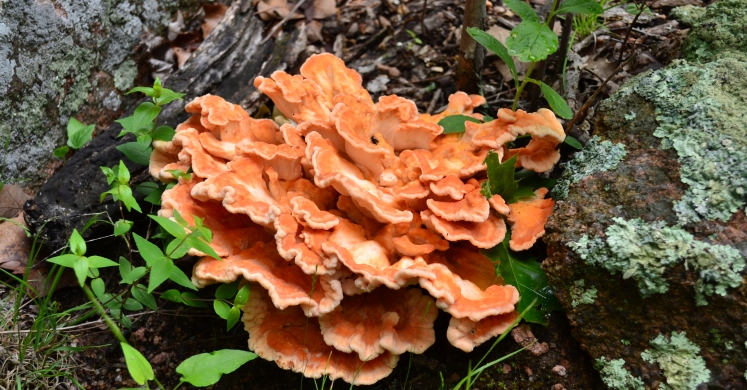Blog

#bioPGH Blog: Chicken of the Woods
 A resource of Biophilia: Pittsburgh, #bioPGH is a weekly blog and social media series that aims to encourage both children and adults to reconnect with nature and enjoy what each of our distinctive seasons has to offer. From the best times to plant seasonal flora and enjoy their peak blooms, to astronomical events and creatures to keep an eye and ear out for, Phipps will keep you in the know with what’s going on in our environment!
A resource of Biophilia: Pittsburgh, #bioPGH is a weekly blog and social media series that aims to encourage both children and adults to reconnect with nature and enjoy what each of our distinctive seasons has to offer. From the best times to plant seasonal flora and enjoy their peak blooms, to astronomical events and creatures to keep an eye and ear out for, Phipps will keep you in the know with what’s going on in our environment!
Why did the chicken cross the road? To get to the other tree! We’re not talking about the feathery avian variety, we’re talking about "chicken of the woods," one of the most delectable fungi in North America (and this author’s favorite). The genus Laetiporus includes several edible mushroom species sometimes referred to as "sulphur shelf," and is a common sight within the deciduous forests of western Pennsylvania; the overlapping tiers of bright orange shelves along tree trunks are hard to miss.
Why such strange names like “chicken of the woods” and “sulphur shelf?” When cooked, Laetiporus mushrooms have a very firm texture, and some aficionados say they taste like chicken. The bright yellow-orange colors give the mushroom its “sulphur” moniker, but thankfully it neither smells nor tastes sulphurous!
Chicken of the woods is a polypore mushroom, releasing spores through pores, rather than gills, on the underside of its cap. It is a “shelf” fungus because it has no real stem the caps grow in thick, interwoven frilly ‘shelves’ on the trunk or stump of a tree. Many fungi are the composters of the food web because they feed on dead organic matter, returning important nutrients back to the soil. Chicken of the woods are no exception: they are saprophytes, meaning they are organisms that feed on dead or dying plants. Hyphae, the threadlike fibers of the fungus (collectively known as mycelium) penetrate the tree, releasing enzymes that break down the heartwood. When conditions are right, the mycelium moves into its reproductive phase, producing the brilliant orange fruiting bodies that release spores.
While chicken of the woods is praised as a choice edible mushroom, it is also a critical component of the forest ecosystem. Aside from its decomposer role, the fungus serves as both a habitat and food source for a wide range of insect species. Scientists found that beetle species diversity within chicken of the woods was much higher than other polypore species. These beetles in turn are responsible for distributing fungal spores.
Connecting to the Outdoors Tip: Recent rainfall has resulted in a proliferation of mushrooms. Chicken of the woods most often associates with oak trees, and older secondary growth forests are the most reliable places to find the fungus. However, Laetiporus can often be found on an old oak tree or stump in your backyard. Some describe this fungus as part of the “foolproof four,” but edibility of Laetiporus mushrooms varies with their host tree, and occasionally some people may have sensitivities to the mushroom. Learning to accurately identify mushrooms takes time and dedication, so please consult with an experienced mycologist before consuming fungi.
The Western Pennsylvania Mushroom Club is very active this time of year, leading mushroom walks almost every weekend over the next few months. This summer the club often found Laetiporus species in the forests around Pittsburgh. The annual Gary Lincoff Mushroom Foray happens Sat., Sept. 24 and features guided and self-guided walks, lectures and other mushroom-related activities. The foray will be led by Gary Lincoff, a mushroom expert, author and past president of the North American Mycological Association (NAMA).
Continue the Conversation: Share your nature discoveries with our community by posting to Twitter and Instagram with hashtag #bioPGH, and R.S.V.P. to attend our next Biophilia: Pittsburgh meeting.
Resources:
Chicken of the Woods | Cornell Mushroom Blog
Chasing Chicken of the Woods | Mushroom Appreciation
Laetiporus sulphureus: The Chicken of the Woods | Mushroomexpert.com
Beetles in Polypores | Entomologica Fennica
Events | Western Pennsylvania Mushroom Club
WPMC Gary Lincoff Foray | Western Pennsylvania Mushroom Club
Select photos © Wikimedia User: Kbh3rd (CC BY 3.0); Wikimedia User: Jsadlow (CC BY 3.0)

